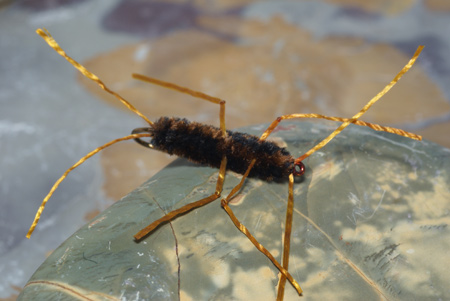Girdle Bug

Hook: Daiichi 2220 or 1720 #4-#8 (weighted)
Thread: MFC 6/0 or UTC 70,Color to compliment body
Tail: Super Floss, color to compliment body
Body: Variegated Chenille
Legs: Super Floss, knotted, color to compliment body
Antenna: Super Floss, color to compliment body
Tying Notes: Intended to suggest stonefly nymphs vary the body and leg colors to match the naturals. Favourite colors include variegated combinations of black, brown, olive and tan. Don’t be afraid to try colourful versions for salmon and steelhead.
It has been said that trout spend up to 90% of their time feeding beneath the surface, often just above the bottom. With this fact in mind it only makes sense to want to get our flies down to the fish. For river and stream patterns this means incorporating weight, and the faster the flow of water is the greater the mass required to get nymphs bouncing and tumbling on or just above the bottom.
Depending upon conditions and personal preferences there are a number of options for adding mass to your flies, all of which can be used separately or in combination with each other. The legendary Frank Sawyer employed copper wire as tying thread and ribbing for his (now standard) Pheasant Tail Nymph. Ever since, other fly-tiers have blended wire into their designs with great effect. John Barr’s Copper John and Skip Morris’s Skip Nymph are two great examples of this technique. In British Columbia tiers such as Gord Honey use wire-bodied chironomid pupa patterns with devastating effect.
Wrapping lead wire around the shank has long been the most popular method for adding weight internally. Lead wire and non-toxic lead wire substitutes are sized in a variety of diameters measured in thousandths of an inch, ranging from .010” to .035”. Use the diameter of the hook shank as a starting point for which size wire to use. The larger the hook, the greater the diameter of the lead wire must be. Swift currents often mean you must overwrap the original lead wire with additional layers to sink your fly. A wide-barrelled floss bobbin dispenses lead wire efficiently if you plan on weighting lots of hooks.
Lead wire can be levelled out using flat nose pliers to protect the slender profile demands of some flies. I often use squashed .010” lead for my chironomid larvae and pupae patterns. Once flattened, the tying thread wraps the lead around the shank, adding weight while still maintaining a svelte profile.
Lead tape has also been popular in Europe for a number of years and is establishing a toehold on the North American scene. Some brands feature a sticky side to adhere the lead to the shank. Trimmed ‘sticky back’ strips are popular for ‘Euro’-style nymphs as they help create more slender weighted foundations.
Since their original introduction through competitive fly-fishing, beads have become a weighting staple. Brass and heavier tungsten beads come in a variety of colours and sizes, most often measured in fractions of an inch. I tend to use brass beads for lakes and tungsten beads for rivers and streams. Many wonder what sized beads to use, so here are my recommendations:
To view the rest of this article, please login or join now for free!
|



